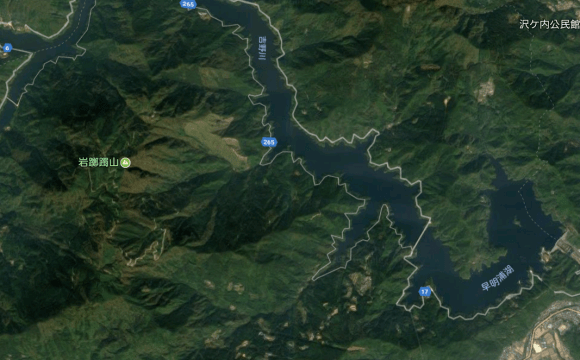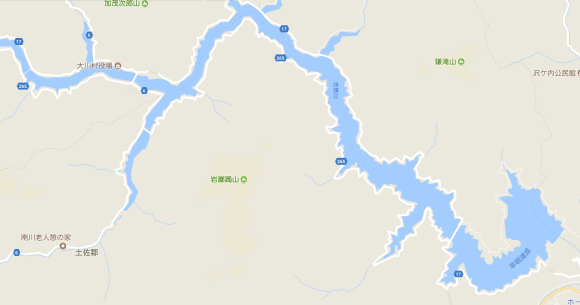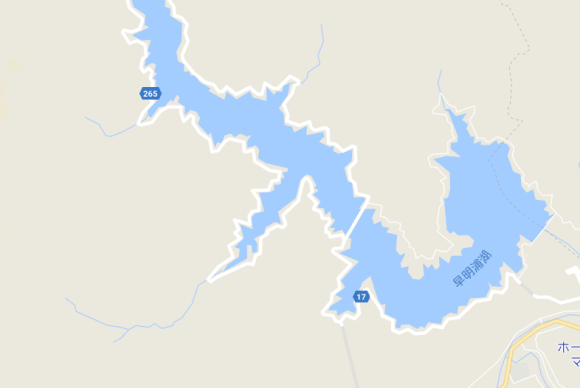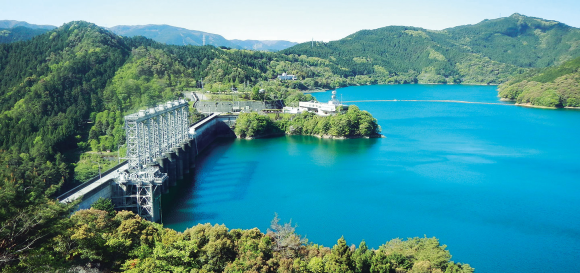Body of water even has a connection to the creatures’ traditional role in Japanese mythology.
Japan’s high-tech, high-speed trains and convenient overnight buses are great ways to get about the country, but it also has an extensive domestic air travel network. Seeing the country from the air can be a real treat, since between its distinct coastlines and compact size it’s easy to pick out landmarks such as cities, islands, and dragons.
Yep, when Japanese Twitter user @chicago0812 was recently flying over Shikoku, the smallest of Japan’s four main islands, he glanced out the window and was met with the image of a majestic mythical serpent.
▼ “There’s seriously a dragon in Shikoku!”
四国にマジでドラゴンいた!! pic.twitter.com/twzBZyNu2J
— 登龍亭獅篭iPhoneでシカゴは一発変換 (@chicago0812) September 1, 2017
Of course, this isn’t a real actual dragon, but a twisting body of water in Kochi Prefecture that happens to look just like the fantasy monster.
The dragon’s tail and body are actually the serpentine Yoshino River, a 194-kilometer (121-mile) waterway that flows from Mt. Kamegamori to Lake Sameura, which forms the dragon’s head.
Still, the uncanny resemblance got Twitter users excited, drawing comparisons to such famous fictional characters as Spirited Away’s Haku, Dragon Ball’s Shen Ron, and Pokémon’s Gyarados.
However, while legends often speak of dragons living in ancient times, the one in @chicago0812’s photo only came into being recently. While the Yoshino River has existed for centuries, Lake Sameura owes its shape to Sameura Dam, which was constructed in 1975.
▼ The lake is a popular tourist destination, with a cycling course lined with 2,000 sakura cherry blossom trees.
This means that we’ll have to give up on our fantasy that long ago a dragon passed away in Shikoku, and when the rains fell on its final resting place, they formed the geographic feature seen in @chicago0812’s snapshot. However, there’s still a mythological connection to be made.
While dragons are typically presented as fire-breathers in Western folklore, in Japan the element they’re most commonly associated with is water, with tales crediting the creatures with causing rainfall in ancient times. As fate would have it, Lake Sameura is a functioning reservoir, and in addition to hydroelectric power from its dam, it also supplies the local communities with drinking and irrigation water, meaning that Shikoku’s dragon is still providing water for the island’s people.
Related: Sameura Dam (Visit Kochi)
Source: Kinisoku, Twitter/@chicago0812
Insert images: Google (1, 2), Visit Kochi





 Oregon as a Studio Ghibli film – Gorgeous tourism video shows the state as a Miyazaki wonderland
Oregon as a Studio Ghibli film – Gorgeous tourism video shows the state as a Miyazaki wonderland Meet Issie, Japan’s very own Loch Ness Monster
Meet Issie, Japan’s very own Loch Ness Monster The strongest peeing boy statue in Japan is a hidden gem of sightseeing in Saitama
The strongest peeing boy statue in Japan is a hidden gem of sightseeing in Saitama Japan’s new luxury sightseeing train will show you part of the country most foreigners never see
Japan’s new luxury sightseeing train will show you part of the country most foreigners never see Step into Spirited Away at Egawa: a site of beauty in Japan that tourists have yet to discover
Step into Spirited Away at Egawa: a site of beauty in Japan that tourists have yet to discover Japan’s new difficult-to-drink-from beer glass protects your liver, but it’s a brutal experience
Japan’s new difficult-to-drink-from beer glass protects your liver, but it’s a brutal experience How to order snacks on a Shinkansen bullet train in Japan
How to order snacks on a Shinkansen bullet train in Japan New Pokémon ice cream, dessert drinks, and cool merch coming to Baskin-Robbins Japan【Pics】
New Pokémon ice cream, dessert drinks, and cool merch coming to Baskin-Robbins Japan【Pics】 Demon Slayer: Kimetsu no Yaiba gets new roller coaster attractions and food at Universal Studios Japan
Demon Slayer: Kimetsu no Yaiba gets new roller coaster attractions and food at Universal Studios Japan Caffeinated ramen for gamers that you can eat with one hand going on sale in Japan
Caffeinated ramen for gamers that you can eat with one hand going on sale in Japan Burger King Japan suddenly adds Dr. Pepper and Dr. Pepper floats to its menu nationwide
Burger King Japan suddenly adds Dr. Pepper and Dr. Pepper floats to its menu nationwide “The most Delicious Cup Noodle in history” – Japan’s French Cup Noodle wins our heart【Taste test】
“The most Delicious Cup Noodle in history” – Japan’s French Cup Noodle wins our heart【Taste test】 New samurai glasses are Japan’s latest weird must-have souvenir
New samurai glasses are Japan’s latest weird must-have souvenir Doraemon found buried at sea as scene from 1993 anime becomes real life【Photos】
Doraemon found buried at sea as scene from 1993 anime becomes real life【Photos】 Hello, cosmetics! Clinique teams up with Hello Kitty this summer for first-time collaboration
Hello, cosmetics! Clinique teams up with Hello Kitty this summer for first-time collaboration Nintendo history you can feel – Super NES, N64, and GameCube controllers become capsule toys
Nintendo history you can feel – Super NES, N64, and GameCube controllers become capsule toys Starbucks releases a cute Frappuccino and Unicorn Cake…but not in Japan
Starbucks releases a cute Frappuccino and Unicorn Cake…but not in Japan Kyoto Tower mascot termination reveals dark side behind cute Japanese characters
Kyoto Tower mascot termination reveals dark side behind cute Japanese characters McDonald’s Japan’s Soft Twist Tower: A phantom ice cream only sold at select branches
McDonald’s Japan’s Soft Twist Tower: A phantom ice cream only sold at select branches Yabai Ramen: What makes this Japanese ramen so dangerous?
Yabai Ramen: What makes this Japanese ramen so dangerous? Finally! Nintendo Japan expands Switch 8-bit controller sales to everybody, Online member or not
Finally! Nintendo Japan expands Switch 8-bit controller sales to everybody, Online member or not Japanese government wants to build luxury resorts in all national parks for foreign tourists
Japanese government wants to build luxury resorts in all national parks for foreign tourists To combat declining birth rate, Japan to begin offering “Breeding Visas” to foreigners
To combat declining birth rate, Japan to begin offering “Breeding Visas” to foreigners 10 things you should buy at 7-Eleven in Japan
10 things you should buy at 7-Eleven in Japan Studio Ghibli releases anime heroine cosplay dresses that are super comfy to wear
Studio Ghibli releases anime heroine cosplay dresses that are super comfy to wear Woman charged for driving suitcase without a license in Osaka
Woman charged for driving suitcase without a license in Osaka Studio Ghibli unveils My Neighbour Totoro miniature house model
Studio Ghibli unveils My Neighbour Totoro miniature house model Kyoto experiencing problems with foreign tourists not paying for bus fares, but not on purpose
Kyoto experiencing problems with foreign tourists not paying for bus fares, but not on purpose Fighting mild hunger with a Japanese soda that turns into jelly in the stomach【Taste test】
Fighting mild hunger with a Japanese soda that turns into jelly in the stomach【Taste test】 Studio Ghibli’s Howl’s Moving Castle tapestry unveiled in Japan for first time
Studio Ghibli’s Howl’s Moving Castle tapestry unveiled in Japan for first time McDonald’s new Happy Meals offer up cute and practical Sanrio lifestyle goods
McDonald’s new Happy Meals offer up cute and practical Sanrio lifestyle goods Sales of Japan’s most convenient train ticket/shopping payment cards suspended indefinitely
Sales of Japan’s most convenient train ticket/shopping payment cards suspended indefinitely Sold-out Studio Ghibli desktop humidifiers are back so Totoro can help you through the dry season
Sold-out Studio Ghibli desktop humidifiers are back so Totoro can help you through the dry season Japanese government to make first change to romanization spelling rules since the 1950s
Japanese government to make first change to romanization spelling rules since the 1950s Foreigner’s request for help in Tokyo makes us sad for the state of society
Foreigner’s request for help in Tokyo makes us sad for the state of society Ghibli founders Toshio Suzuki and Hayao Miyazaki contribute to Japanese whisky Totoro label design
Ghibli founders Toshio Suzuki and Hayao Miyazaki contribute to Japanese whisky Totoro label design Tokyo’s most famous Starbucks is closed
Tokyo’s most famous Starbucks is closed Princesses, fruits, and blacksmiths: Study reveals the 30 most unusual family names in Japan
Princesses, fruits, and blacksmiths: Study reveals the 30 most unusual family names in Japan Three’s a crowd as multiple waterspouts form above Chinese lake in awesome video
Three’s a crowd as multiple waterspouts form above Chinese lake in awesome video Zelda’s Akira Himekawa reveal Kamdo fantasy manga set in ancient Japan
Zelda’s Akira Himekawa reveal Kamdo fantasy manga set in ancient Japan Top 10 places to see a spectacular sunset in Japan
Top 10 places to see a spectacular sunset in Japan Dragon Ball characters appear in Ford anime ad specifically made for English-speakers 【Video】
Dragon Ball characters appear in Ford anime ad specifically made for English-speakers 【Video】 Karate dojo students practice under freezing waterfall… in the middle of winter
Karate dojo students practice under freezing waterfall… in the middle of winter Hokkaido has an otherworldly giant hot spring that’s easy to miss if you don’t know where it is
Hokkaido has an otherworldly giant hot spring that’s easy to miss if you don’t know where it is China’s polluted rivers can be surprisingly pretty, but might turn you into a mutant
China’s polluted rivers can be surprisingly pretty, but might turn you into a mutant Awesome origami artist recreates the creatures of Monster Hunter 【Videos】
Awesome origami artist recreates the creatures of Monster Hunter 【Videos】 Hokkaido’s Shikaribetsuko Kotan — the beautiful village of ice that melts away in the spring
Hokkaido’s Shikaribetsuko Kotan — the beautiful village of ice that melts away in the spring Studio Ghibli creates amazing crossover illustration for Twitter Japan
Studio Ghibli creates amazing crossover illustration for Twitter Japan Starbucks releases a dragon latte containing Japanese pepper in Japan
Starbucks releases a dragon latte containing Japanese pepper in Japan Dungeons & Dragons Pokémon fanart inspires incredible cosplay group
Dungeons & Dragons Pokémon fanart inspires incredible cosplay group Shaolin monk “walks on water,” smashes world record
Shaolin monk “walks on water,” smashes world record New Dragon Ball anime series announced, turns Goku and friends into babies【Video】
New Dragon Ball anime series announced, turns Goku and friends into babies【Video】 A Gintama fan’s emotional 19-year journey to buy a proper Lake Toya bokuto wooden katana【Pics】
A Gintama fan’s emotional 19-year journey to buy a proper Lake Toya bokuto wooden katana【Pics】
Leave a Reply